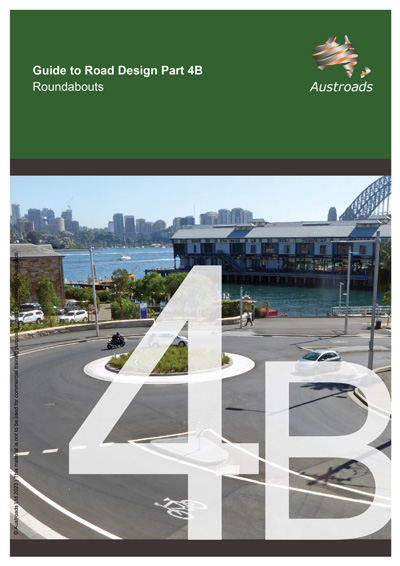Road Design

- Publication no: AGRD04B-23
- ISBN: 978-1-925294-84-2
- Published: 29 May 2023
- Edition: 3.2
- PDF (free) Download
The Guide to Road Design Part 4B: Roundabouts provides road designers and other practitioners with guidance on the geometric design of roundabouts. It covers design principles and procedures, and guidelines for all the key elements, thus enabling practitioners to develop safe and efficient layouts.
Part 4B also provides information on pedestrian and cyclist treatment at roundabouts and related topics such as pavement markings, signs and landscaping.
Designers should refer to other relevant parts of the Austroads Guide to Road Design and to the Austroads Guide to Traffic Management Part 6: Intersections, Interchanges and Crossings Management that cover traffic management and road use aspects of roundabouts and criteria for the appropriate selection and design of intersections.
Edition 3.2 contains technical changes and editorial changes to sections 1.8, 3.2.4, 4.2, 4.6, 5.1, 5.2 5.3.3, 5.3.6, and 10.1. It also contains new guidance in Section 4.11.3 for mini roundabouts, Section 4.11.4 for radial roundabouts and Section 5.3.7 for cyclist and pedestrian priority at roundabouts.
Edition 3.1 of the Guide replaces figure 1.1 and contains technical changes and minor editorial changes to Sections 1.6, 2.2, 4.1, 4.4, 4.5 and 5.3.
Edition 3.0 contains technical changes and minor editorial changes to Sections 1.3, 1.6, 1.9, 4.3, 4.4, 4.5, 4.7, 4.9, 5.3, 6.3, and 7 and the addition of information relating to the extended design domain for vehicle entry path radii. Updates have been made throughout this edition to include new and updated reference material and cross-references added to other Guides, including:
- Section 1 Introduction: updates to road safety including Safe System; additional information relating to motorcycles; and Section 1.9 deleted and replaced with information on roundabouts in high-speed areas.
- Section 4 Geometric Design: additional information on entry, circulating and exit lanes; additional information on the central island radius and amendment to Table 4.1; amended information on approach treatments; amended Table 4.2 – Maximum entry path radii; additional information on exit curves; additional information of the separation of the roundabout legs.
- Section 5 Pedestrian and Cyclist Treatments: information on bicycles at roundabouts amended, including deletion of commentary and figures relating to bicycle lanes within roundabouts.
- Section 6 Pavement Markings and Signing: amended information on the use of spiral linemarking.
- Section 7 Roadway Lighting at Roundabouts: deleted.
- Appendix E Extended Design Domain for Entry Path Radii: new
- 1. Introduction
- 1.1 Purpose
- 1.2 Scope of this Part
- 1.3 Road Safety
- 1.4 Road Design Objectives
- 1.5 Traffic Management at Roundabouts
- 1.6 Safety Performance of Roundabouts
- 1.7 Traffic Capacity of Roundabouts
- 1.8 Signalisation of Roundabouts
- 1.9 Roundabouts in High-speed Rural Areas
- 2. Design Principles and Procedure
- 2.1 Terminology
- 2.2 Design Principles
- 2.3 Design Procedure
- 3. Sight Distance
- 3.1 Introduction
- 3.2 Sight Distance Criteria
- 3.2.1 Criterion 1
- 3.2.2 Criterion 2
- 3.2.3 Criterion 3
- 3.2.4 Pedestrian Visibility
- 3.2.5 Other Visibility Considerations
- 3.3 Stopping Sight Distance for Trucks
- 4. Geometric Design
- 4.1 Introduction
- 4.2 Number of Legs
- 4.3 Number of Entry, Circulating and Exit Lanes
- 4.3.1 Introduction
- 4.3.2 Number of Entry Lanes
- 4.3.3 Number of Circulating Lanes
- 4.3.4 Number of Exit Lanes
- 4.3.5 Left-turn Slip Lanes
- 4.3.6 Special Use Lanes
- 4.4 Central Island
- 4.4.1 Central Island Shape
- 4.4.2 Factors Affecting Central Island Size
- 4.4.3 Central Island Radius
- 4.5 Approach and Entry Geometry
- 4.5.1 General
- 4.5.2 Approach and Entry Treatments
- 4.5.3 Maximum Entry Path Radius
- 4.5.4 Splitter Islands
- 4.6 Circulating Carriageway
- 4.6.1 Design Vehicle and Vehicle Swept Paths
- 4.6.2 Width of Circulating Carriageway
- 4.6.3 Encroachment Areas
- 4.7 Exit Curves
- 4.8 Entry and Exit Widths
- 4.9 Separation between Legs
- 4.10 Superelevation, Gradient and Drainage
- 4.10.1 Crossfall
- 4.10.2 Approach Grade
- 4.10.3 Drainage
- 4.11 Special Treatments
- 4.11.1 Wide Medians and Streets of Unequal Width
- 4.11.2 Wide Undivided Streets and T-intersections
- 4.11.3 Mini-roundabouts
- 4.11.4 Radial Roundabouts
- 5. Pedestrian and Cyclist Treatments
- 5.1 Introduction
- 5.2 Pedestrians
- 5.2.1 Safety Analysis of Roundabouts for Pedestrians
- 5.2.2 Designing Roundabouts for Pedestrians
- 5.3 Cyclists
- 5.3.1 Introduction
- 5.3.2 Safety Analysis of Roundabouts for Cyclists
- 5.3.3 Designing Roundabouts for Cyclists
- 5.3.4 Roads with Shared Traffic
- 5.3.5 Multilane Roundabouts
- 5.3.6 Bicycle Paths and Shared Paths at Roundabouts
- 5.3.7 Priority for Cyclists and Pedestrians at Roundabouts
- 5.3.8 Other Considerations
- 6. Pavement Markings and Signing
- 6.1 Introduction
- 6.2 Single-lane Local Street Roundabout
- 6.3 Multilane Arterial Road Roundabout
- 7. Landscaping and Street Furniture
- 7.1 Introduction
- 7.2 Arterial Road Roundabouts
- 7.3 Local Street Roundabouts
- 7.4 Maintenance
- References
- Appendix A Crash Types
- A.1 Australia
- A.2 New Zealand
- Appendix B Roundabout Study and Program
- Appendix C Methods of Improving Roundabout Entries
- C.1 Introduction
- C.2 Examples of Improved Roundabout Entries
- Appendix D Linemarking of Multilane Roundabouts
- D.1 Introduction
- D.2 Single-lane Exits Adjacent to Two Circulating Lanes
- D.2.1 Examples A and B of Figure D 5
- D.2.2 Example C of Figure D 5
- D.2.3 Example D of Figure D 5
- D.2.4 Conclusion
- Appendix E Extended Design Domain (EDD) for Entry Path Radii
- Commentary 1
- C1.1 General
- C1.2 Pedestrians and Cyclists
- Commentary 2
- Commentary 3
